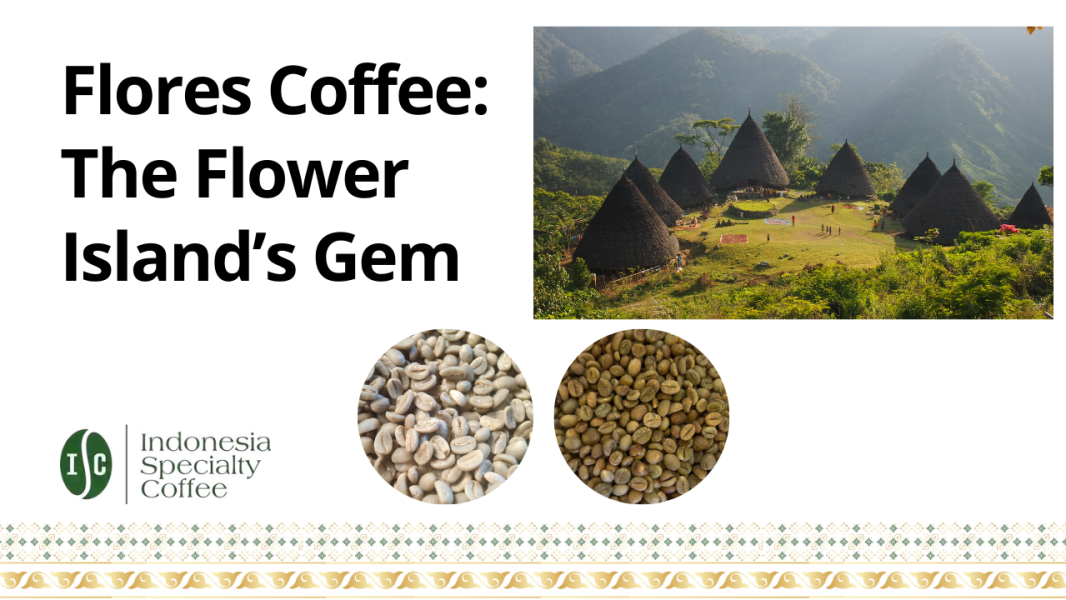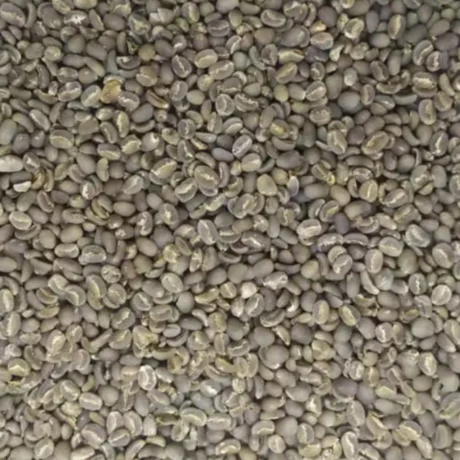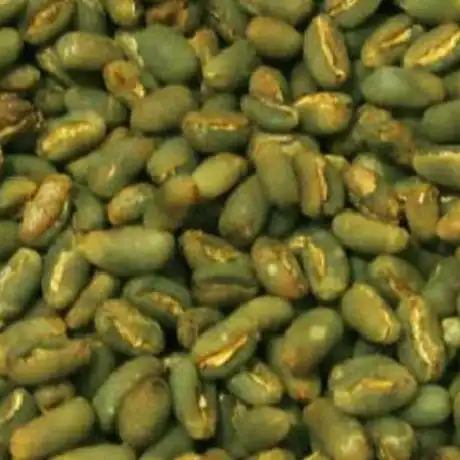What is Flores Coffee?
Flores Coffee is a Coffee Variety from Flores Island, located in East Nusa Tenggara Province, Indonesia. Flores Island is famous for its natural beauty such as Kelimutu Lake, Komodo National Park, and the rich culture of its diverse tribes. The name Flores itself comes from the Portuguese language, meaning flower. This name was given because of the island’s natural beauty and its diversity of plants and flowers.
Flores Island is home to high-quality coffee. Flores coffee has gained recognition internationally as one of the best coffees from Indonesia, standing alongside other famous origins such as Sumatra (Gayo, Mandheling, Lintong) and Java (Ijen & Preanger).
Even though Flores coffee is not yet as popular in the global market compared to Sumatra or Java, its quality is not inferior. The island produces both Arabica and Robusta coffee, each with distinct characters that reflect the unique environment of Flores.
History of Flores Coffee
According to Gramedia.com, Coffee arrived in Flores during the Dutch colonial era, the 1920s, and the early 20th century. At that time, the Dutch introduced Arabica to several highland areas in Flores, especially Manggarai, Bajawa, and Ende. The Typica variety was among the first planted, and some of these old trees can still be found today in traditional farms.
After independence, coffee remained an important smallholder crop. Most of the farmers in Flores are small-scale producers, working with family-owned land and cultivating coffee alongside food crops. Unlike Java, which had large colonial plantations, Flores coffee was mostly developed in small community-based farms.
In the 1970s and 1980s, government research centers introduced new cultivars such as Catimor, S795, and Kartika to replace or mix with the older Typica. This helped farmers increase productivity and fight leaf rust disease. Robusta was also introduced in lower areas like Ende, Sikka, and Larantuka, supported by clones such as BP 42 and BP 308.
In more recent decades, Flores coffee started to gain recognition in the specialty coffee market. Exporters and cooperatives began to highlight Bajawa Arabica as a distinct origin, with its fruity and floral flavor profile. Although Flores still lags behind Sumatra and Java in international fame, its history of cultivation, adaptation, and community farming has shaped it into one of Indonesia’s most promising coffee regions.
Challenges in Recognition
Although Flores produces excellent coffee, the island is still less recognized compared to Sumatra and Java. Farmers in Flores often focus only on cultivation and post-harvest, but they are not as experienced in export and international trade. In contrast, producers from Sumatra and Java have long-established connections with exporters and global buyers.
This situation makes Flores coffee less visible in the world market. Many times, the beans are sold through middlemen or blended into other regional lots, so the identity of Flores as an origin becomes hidden.
The cup quality of Flores coffee is outstanding. Its Arabica carries fruity and floral notes with balanced body and acidity, while its Robusta shows strong earthy characters. With proper promotion and stronger export networks, Flores coffee can rise to the same level of fame as Sumatra and Java.
Arabica Coffee of Flores

Cultivars (Varieties)
Arabica coffee in Flores is diverse, with several cultivars planted across the island:
- Catimor (Chatimor) – a cross between Caturra and Timor Hybrid. It is resistant to leaf rust and suitable for Flores’ climate. Common in Manggarai and Ngada.
- Ateng (Ateng Jaluk) – widely planted, though less famous compared to Gayo’s Ateng in Sumatra.
- S795 (Jember / Line S) – a popular variety in many regions of Indonesia, also cultivated in Flores.
- Typica – the classic, old Arabica variety. Now rare, but still found in older farms.
- Tim Tim (Timor Hybrid) – originally from Timor, later became a parent variety for Catimor.
- Kartika – developed by research in Jember, known for its good productivity and quality.
Growing Regions & Altitude
Flores Arabica grows best at altitudes between 1,000 – 1,800 meters above sea level.
The main growing areas include Manggarai, Manggarai Timur, Ngada (Bajawa), Ende, and Lembata. These highlands provide ideal conditions for Arabica coffee cultivation.
Cup Profile
The general taste profile of Flores Arabica is:
• Body: medium to full
• Acidity: medium
• Flavors: fruity notes such as berry and citrus, floral aroma, with hints of chocolate, caramel, and sweet tobacco.
Screen Size
Arabica Flores Coffee has a 15-16 screen size, quite the same if compared with Sumatra Arabica and Java Arabica.
The screen size for coffee beans is measured using a system of sieves with round holes of specific diameters, and the unit is in 1/64 of an inch.
So, for example:
- Screen size 13 → hole diameter is 13/64 inch (≈ 5.16 mm).
- Screen size 14 → 14/64 inch (≈ 5.56 mm).
- Screen size 15 → 15/64 inch (≈ 5.95 mm).
- Screen size 16 → 16/64 inch (≈ 6.35 mm).
- Screen size 17 → 17/64 inch (≈ 6.75 mm).
- Screen size 18 → 18/64 inch (≈ 7.14 mm).
So Flores Arabica is usually screened 15–18, which means most beans are around 5.95–6.35 mm in diameter, which is considered relatively same same-sized beans compared to Sumatra or Java Arabica.
Processing Methods
In Flores, Arabica is dominantly processed with the fully-washed method. This is different from Sumatra and Java, where semi-washed (wet-hulled) is more common.
Other processes, such as natural, honey, wine, or semi-washed, are possible, but usually only made to order. Farmers need to receive specific requests first before preparing coffee cherries for those methods.
Robusta Coffee of Flores

Cultivars (Varieties)
Robusta is also planted in Flores, although its total area is smaller compared to Arabica. The main cultivars include:
- BP 42 (Bina Pitoyo 42) – a leading variety developed in Jember, productive at low to medium altitudes.
- BP 308 – another strong and high-yielding variety, well-accepted by local farmers.
- SA 237 & SA 436 – selections originally from Sumatra, adapted for Flores conditions.
- Local farmer selections – older Robusta plants passed down from generation to generation, often without formal cultivar names.
- Government-distributed clones – such as UGM and Jember selections (BP 409, BP 430, etc.), were introduced to improve productivity.
Growing Regions & Altitude
Flores Robusta grows at lower elevations, around 200 – 800 meters above sea level. The main producing regions include Ende, Sikka, Larantuka, and East Flores (Flores Timur).
Cup Profile
The cup profile of Flores Robusta is distinctive:
- Body: high, heavy mouthfeel
- Acidity: low
- Flavors: earthy, strong bitterness, bold and intense character
Screen Size
One unique aspect of Flores Robusta is its smaller bean size, 13–14 or below, compared to Robusta from Sumatra or Java. In contrast, Robusta from Sumatra and Java more often falls in the 15–18 screen range. For Arabica, the screen size is similar to other regions, typically 15–16.
Larger beans (screen 15–18) exist but are not common.
Processing Methods
Flores robusta coffee processing is 80% Natural process and 20% Honey process, said Paul, one of our Flores coffee suppliers.
Comparison with Other Indonesian Coffees
When we compare Flores coffee with other well-known Indonesian origins, the differences become clear:
Sumatra (Gayo, Mandheling, Lintong)
- Reputation: already globally recognized for decades.
- Profile: heavy body, earthy, spicy, complex layers.
- Processing: dominantly semi-washed (wet-hulled).
Java (Preanger, Ijen, etc.)
- Reputation: historically famous since colonial times.
- Profile: clean cup, medium body, balanced acidity, often with sweet and herbal notes.
- Processing: more washed, some natural.
Flores
- Reputation: newer in global recognition, still growing in exposure.
- Arabica Profile: fruity, floral, medium–full body, citrus, berry, chocolate, caramel.
- Robusta Profile: bold, earthy, smaller screen size, strong bitterness, high body.
- Processing: dominantly fully-washed for Arabica, with other methods available on request.
In short, Flores coffee holds a unique position. While Sumatra and Java have long-standing global reputations, Flores offers a different sensory experience—floral and fruity Arabicas from highland regions, and bold Robustas from lower areas.
Conclusion
Flores is not only an island of natural beauty and cultural diversity, but also a land of remarkable coffee. Both Arabica and Robusta from Flores show unique characteristics that deserve recognition on the same level as Sumatra and Java.
- Arabica brings medium to full body, fruity and floral notes, with chocolate and caramel sweetness.
- Robusta delivers bold, earthy flavors, strong bitterness, and a distinct, smaller bean size.
The challenge lies not in quality, but in recognition and market access. Many farmers in Flores are not yet as connected to international trade as their counterparts in Sumatra or Java. However, with stronger promotion and support in export channels, Flores coffee has the potential to stand proudly as one of Indonesia’s coffee icons.
Get your Flores coffee from us! Contact us at info@specialtycoffee.id
Check our Flores Coffee product here: Flores Green Coffee Beans





